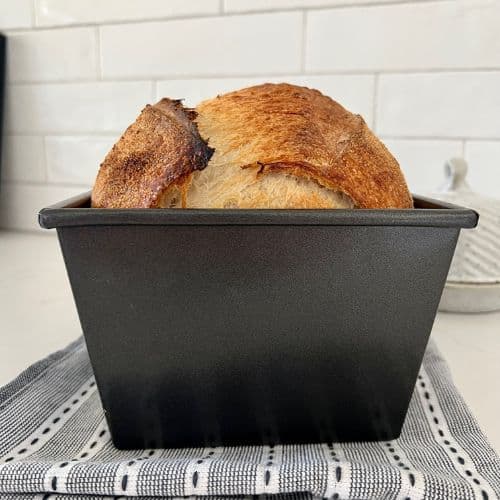How To Bake Sourdough In A Loaf Pan
4.2
(79)
Your folders
Your folders
Prep Time: 240 minutes
Cook Time: 45 minutes
Total: 1005 minutes
Servings: 1

Ingredients
Export 2 ingredients for grocery delivery
Instructions
Step 1
Weigh out your sourdough starter and water into a large mixing bowl and mix together briefly.
Step 2
Now add your flour and salt and mix whole lot together to form a dry dough.
Step 3
Cover your bowl with cling film or a damp tea towel and let it sit for around 1 hour. This process is called the "autolyse" and allows your flour to soak in all the water and become hydrated. You can see how the dough has changed in this photo.
Step 4
Bring the dough together into a ball. Pull the edges of the dough into the centre until it's smoother and more formed.You'll notice that the dough is fully hydrated after soaking all the water up. It will be fairly sticky but as you bring it into a ball, it will become smoother and shinier.
Step 5
Once the dough has formed into a smooth ball, pop the cling film back on and let it rest for 30 minutes.
Step 6
Over the next few hours you need to create some structure for your dough by "stretching and folding". Aim to do around 4-6 sets of stretches and folds. For each set, stretch the dough up and over itself 4 times. Leave around 15 minutes in between each set. Again you do not have to be exact with time, but you need to do at least 4 sets over 2 hours.
Step 7
Once you've finished your stretch and folds, place the cling film or damp tea towel back over your dough and let it rest and ferment (a plastic cover is a better option for this stage).
Step 8
Once your dough has finished its first ferment, it's time to shape it so that it will fit into your loaf tin. Shaping your dough into a batard is the best for proofing and baking in a loaf tin.You'll need to flour your counter top with rice flour for this (we use rice flour because it has no gluten). Try to be quite sparing with the rice flour, you only need a very light dusting. Semolina is also ok for this.Use a silicone dough scraper to gently ease the dough out of the bowl. You want it to land upside down on your counter so that the smooth top of the dough is on the countertop and the sticky underside is facing up. This will make it easier to shape.Shape the dough into a batard or loaf shape (you can see instructions for this here).
Step 9
Lightly coat the inside of your loaf tin with butter. Dust it with semolina or rice flour.Once the dough is shaped, you need to gently lift it into the loaf pan. You need to place it into the loaf tin with the seam on the bottom (opposite to how you would place it into a banneton).
Step 10
Now the dough is in the loaf tin, you need to let it proof. For this sourdough loaf I like to proof it a little on the counter first and then put it in the fridge until I'm ready to bake. As long as it didn't over ferment during bulk fermentation, allow the dough to puff up a bit before you put it in the fridge for cold fermentation. Don't let it go too far though or you won't have any oven spring.
Step 11
Once you're ready to bake your sourdough, you'll need to preheat your oven to 200C/392F.
Step 12
Now it's time to bake!When the oven is at temperature, take your loaf of sourdough out of the fridge and score it (you don't have to score it if you don't want to). Lightly spray the top of the dough with water. Place it into the hot oven.BAKE TIME:45 Minutes at 200C/392F
Step 13
When your sourdough is done, remove it from the oven. Let it sit for a few minutes and then carefully remove it from the tin. Place onto a wire rack to cool.If you wish to soften the crust a little, you can brush the top of the loaf with melted butter if you wish.